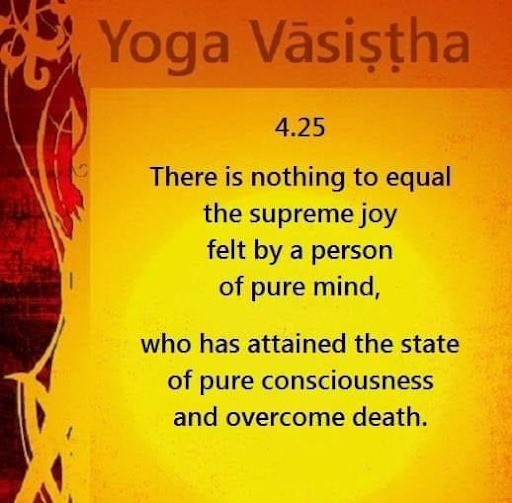#Yoga vasistha
Photo

Tomas Sanchez, In the Inner Landscape
* * *
“Hail the Eternal.
Om, salutation to the self-same Reality, from whom all
beings proceed, by whom they are manifest, upon whom
they depend, and in whom they become extinct.
He is the knower, the knowledge and all that is to be
known. He is the seer, the seeing, and all that is to be seen.
He is the actor, the cause and the effect: therefore
salutations to Him (who is all) knowledge Himself.
Salutation to Him (who is) supreme bliss itself, from whom
flow the dews of delight (as water springs from a fountain)
both in heaven and earth, and who is the life of all.”
— Vālmīki, Yoga Vāsistha
#Tomas Sanchez#In the Inner Landscape#Art#Beauty#Painting#Visionary#Valmiki#Yoga Vasistha#Wisdom#Yoga#Ancient India#Om#Reality
27 notes
·
View notes
Text


3 notes
·
View notes
Text

Vasiṣṭha's Yoga By Swami Venkatesananda
0 notes
Text

#yoga vasistha#rumipoetry#mevlana celaleddin rumi#spiritual poetry#enlightenment#spiritual community#spiritual life#jalaluddin rumi#rumi quotes#rumi
0 notes
Text
Yoga Vasistha
Yoga Vasishta is the pioneering Vedantic wisdom on the nature of existence and reality and veritably the forerunner of the Bhagavad Gita in its convergence of the paths of jnana and karma. This precious knowledge was imparted to Prince Rama at a moment of confusion and crisis when the young prince was beginning to feel a surge of vairagya at a tender age.
While extolling the vairagya state, Vasishta initiates Rama into the deeper aspects of existence especially the nature of the mind. He makes a metaphorical comparison of peace, discrimination, contentment and company of sages, to the four sentinels guarding the gate of moksha. In Yoga Vasishta, the sage advises Rama that the world of phenomena is nothing but a jugglery of the Mind. It can be discerned only through self-introspection. The mind engrossed in its own nature forgets the Eternal Spirit and must return again to this world, never attaining spiritual felicity. As a sadhak, one needs to cultivate the aforementioned four traits to prevent the mind from getting distracted
In one of his many anecdotes, Sage Vasishta narrates how Sukracharya in meditation got distracted by a celestial nymph, and slipped into a reverie that led him to attachments, a series of births, till he was rescued from the twilight state and shown his true nature as the meditating Sukra. Through an elaborate understanding of the mind as the seat of illusion, Sage Vasishta exhorts Rama to adopt the path of karma, dissuading him from renunciation.
Equally, an honest man dwells amongst thieves only so long as he does not know them as such. No sooner does he come to know them than he is sure to shun their company and flee from the spot. So too the mind dwells amongst unreal dualities as long as it is ignorant of the transcendent One. But when it becomes aware of True Unity, it is sure to be united with it.
Some of the most profound moments are when we listen to these words of Vasishta: “O Rama, maya is such that it brings delight through its own destruction; its nature is inscrutable; it ceases to exist even while it is being observed. Just as a tree consisting of fruits, leaves, creepers, flowers, branches, twigs and roots, exists in the seed of the tree, even so this manifest world exists in Brahman.
Just as the dream becomes unreal in the waking state and the waking state in the dream, so also death becomes unreal in birth and birth in death. It is little surprise that this pioneering wisdom has already inspired series of Hollywood blockbusters in the past decade. For years now we have been keen to grasp teachings but could not progress beyond a few pages of the book.
0 notes
Text






Sunday Excursion to Vasisthta Cave: Experience spiritual serenity with a Sunday excursion to Vasistha Cave. An ashram located near Mother Ganga, this sacred site offers meditation, tranquillity, and breathtaking views, a day of calmness and peace.
.
Join us for the next 200 Hour Yoga TTC program: https://adiyogaashram.com/200-hour-yoga-teacher-training-course-in-rishikesh.php
7 notes
·
View notes
Text
Something Royally Fishy
There are a number of critical times in my life, like when I left my Twin Galaxies job in the summer of 2000, that I’m now, looking back, quite certain were the work of criminals. In the case of Twin Galaxies, and my leaving for a vacation with Bryce Allen and my father to Europe, I think the criminals got my parents to persuade me to quit, and go on the vacation, because it was a good job, and they wanted to make me look like I didn’t care about having one, which I do. Inviting Bryce, which my mom did (I had thought maybe I’d see him in Italy for a few days, not let him into my family’s homes, which is sensitive for me), i think was also the work of criminals because as I mentioned in another post, he was and maybe still is a criminal and conspirator. In the case of my becoming a United States citizen, also, I think my parents were persuaded by criminals to persuade me. And in the case of my being persuaded to be on the Maharishi Purusha Program, it happened after a conversation with Neil Patterson, in the form of what he wrote on his card and in a copy of Vasistha’s Yoga: he persuaded me to go and I think that was the work of criminals, getting me involved in spiritual indolence, the worse thing one can do according to Yogananda. I’m looking forward to my reading of his book God Talks To Arjuna today: that’s where I read about spiritual indolence.
10 notes
·
View notes
Text

''Only when one severs the very root of the mind with the weapon of non-conceptualization, can one reach the Absolute Brahman which is omnipresent, supreme peace.
First destroy the mental conditioning by renouncing cravings; and then remove from your mind even the concept of bondage and liberation. Be totally free of conditioning.
Ideas and thoughts are bondage; and their coming to an end is liberation. Therefore, be free of them and do whatever has to be done spontaneously.''
-Yoga Vasistha
'You can see forever', by J. Beloussow
5 notes
·
View notes
Text
This barrier cannot be broken because it is not there. This is what the oriental philosopher calls avidya — ignorance or maya — illusion. It is not as though 'this' is an illusion. It is not there, and yet I am thoroughly convinced it is there, and therefore I cannot get rid of it. The difficulty is that the more I struggle to get rid of it, the firmer it becomes established. Therefore we return to a very beautiful expression found both in the Yoga Vasistha and the Bhagavad Gita: 'Only Grace can help you, nothing else can.' The more you struggle, the worse the problem becomes, and yet Grace compels you to struggle. It is a strange phenomenon. You struggle and struggle, and if you do not struggle, then it means you have not experienced Grace. Grace makes you restless, and restlessly struggling against this non-existent obstacle, you despair. You realise that struggle does not get you anywhere, and you realise that you cannot help struggling. It is a whole mess. Then suddenly Grace reveals, 'This is what it is.'
-- Swami Venkatesananda, Multiple Reflections: Talks on the Yoga Vasistha
15 notes
·
View notes
Note
this excerpt has been my favorite and just wanted to share it
"the mental appearance of the visible world deludes its beholder in the same way a fantasy appearance of a ghost misleads a child" -Yoga vasistha-
Thank you so much!! And factsss like it’s a really mind-blowing concept
14 notes
·
View notes
Text
Books I'll read
Avadhuta gita❗
Autobiography of Ram Krishna paramhans
A Himalayan yogi ❗
Living with the Himalayan master ( by Swami Rama)❗
Play of consciousness - spiritual autobiography (by Swami muktananda)❗
I am that ( by sri nisargadatta maharaj)❗
Future crimes❗
Zen yoga❗
Tao te Ching ❗
the Hindu-Yogi science of breath by ramacharaka❗
Positive personality profile ❗
कल्चर यक्साॅं ❗
Dopamin nation❗
Leaders eat last by Simon sinek❗
21 lessons for the 21th century ❗
The brain (by David eagleman)❗
the Crime and punishment (fyodot dostoyevsky)❗
The Principal upnishad (by Sarvepalli Radhakrishnan) ❗
Kularnava tantra❗
चित शांति के स्रोत कबीर के दोहे ❗
Je suis - sri nisargadatta maharaj ❗
You are not alone ❗
I am watching you (by teresa Driscoll )❗
Power of now ❗
Master your emotions ❗
The arthshastra by Kautilya❗
The Happiness hypothesis❗
Apprenticed to a Himalayan yogi❗
Life after life ❗
Think on these things by j Krishnamurti❗
The supreme yoga (yoga vasistha)❗
Many lives many masters ❗
The journey home ❗
Hsin hsin ming: understanding of mind and consciousness❗
नाराज़❗
An Advance history of India❗
India that is bharat ❗
मीरा प्रेम दीवानी❗
Unity purity divinity ❗
The obstacles is the way ❗
Walden ❗
Big theory of everything❗
Blindness❗
Capital (das capital)❗
The wealth of nation ❗
Life 3.0❕
The history of philosophy❗
विचारों की बूंदे (by upa Chauhan)❗
Success by Emily Dickinson❗
A L basham the wonder that was india❗
A History of hindu chemistry ❗
4 notes
·
View notes
Text

“He is a happy man whose mind is inwardly cool and free from attachment and hatred and who looks upon this (world) like a mere spectator.”
― Yoga Vasistha
1 note
·
View note
Text
Verse 12.12 - Bhakti Yoga
श्रेयो हि ज्ञानमभ्यासाज्ज्ञानाद्ध्यानं विशिष्यते ।ध्यानात्कर्मफलत्यागस्त्यागाच्छान्तिरनन्तरम् ॥ १२-१२॥
Better than mechanical practice (of religion) is Real Knowledge; better than knowledge is meditation. Better than meditation is renunciation of the fruits of actions, for peace immediately follows such renunciation.
The verse is part of the chapter on Bhakti Yoga, or the path of devotion, in which Lord Krishna explains the different ways of attaining Him. He begins by describing the highest form of devotion, which is to love Him without any selfish motive, and to see Him in all beings. He then proceeds to explain the lower forms of devotion, which are based on various degrees of attachment and desire. He also gives the criteria for choosing the appropriate form of devotion according to one's temperament and qualification.
The verse compares four levels of spiritual practice: mechanical practice, knowledge, meditation, and renunciation of the fruits of actions. Mechanical practice refers to the performance of rituals and duties without understanding their significance or purpose. Knowledge refers to the intellectual comprehension of the scriptures and the teachings of the guru. Meditation refers to the mental concentration on the object of devotion, such as the name, form, or qualities of the Lord. Renunciation of the fruits of actions refers to the attitude of offering all one's actions to the Lord, without expecting any reward or result.
The verse states that each level of practice is better than the previous one, as it leads to a higher degree of detachment, purity, and devotion. The verse also states that the highest level of practice is renunciation of the fruits of actions, which brings immediate peace to the mind. This is because such a practice frees one from the bondage of karma, which is the cause of suffering and rebirth. By renouncing the fruits of actions, one surrenders one's will to the Lord, and becomes His instrument. Such a devotee attains the supreme state of bliss and union with the Lord.
The verse can be compared with similar verses from other Vedic texts, as follows:
- In the Katha Upanishad, Yama, the god of death, teaches Nachiketa, a young seeker, the secret of immortality. He says:
नाविरतो दुष्चरितान्नाशान्तो नासमाहितः ।नाशान्तमानसो वाऽपि प्रज्ञानेनैनमाप्नुयात् ॥ २.२४॥
One who has not turned away from evil conduct, whose senses are not subdued, whose mind is not concentrated, whose mind is not pacified, can never attain this Self by knowledge.
This verse emphasizes the importance of ethical conduct, sense control, mental concentration, and inner peace for the attainment of Self-knowledge, which is the ultimate goal of Vedanta.
- In the Yoga Sutras of Patanjali, the authoritative text on the science of Yoga, the eight limbs of Yoga are described. The last three limbs are dharana (concentration), dhyana (meditation), and samadhi (absorption). Patanjali defines them as:
तत्र प्रत्ययैकतानता ध्यानम् ॥ ३.२॥तदेवार्थमात्रनिर्भासं स्वरूपशून्यमिव समाधिः ॥ ३.३॥
Meditation is the continuous flow of the same thought or image of the object of concentration. Samadhi is when the object of meditation shines forth alone, as if devoid of the form of one's own Self.
These verses explain the nature and goal of meditation, which is to attain the state of samadhi, where the distinction between the meditator, the object of meditation, and the act of meditation dissolves, and only the Pure Consciousness remains.
- In the Yogavashishta, a philosophical text attributed to sage Valmiki, the dialogue between sage Vasistha and prince Rama is recorded. Vasistha teaches Rama the essence of Advaita Vedanta, which is the non-dual reality of Brahman, the supreme Self. He says:
अहं ब्रह्मास्मि ब्रह्मैवाहमस्मि ब्रह्माहमेवाहम् । अहं ब्रह्माहमखण्डबोधोऽहं ब्रह्माहमश्नुते ॥ ५.६०.१७॥
I am Brahman, I am indeed Brahman, I am Brahman alone, I am Brahman. I am Brahman, I am indivisible Knowledge, I am Brahman, I am Bliss.
This verse expresses the Realization of the identity of one's own Self with the Absolute Reality, which is the Source of all existence, Knowledge, and Bliss. This is the ultimate aim of Vedanta, to realize one's True Nature as Brahman.
1 note
·
View note
Text
Yoga Vasistha - Pranayama
Yoga Vasistha – Pranayama
Now hear about the characteristics of Pranas. The inhalation, to the length of twelve digits, of the Prana which has been exhaled is called (the internal) Puraka (inhalation.) It is also called the (internal) Puraka, when Apana Vayu re-enters the body from the outside without any effort. When Apana Vayu ceases to manifest itself and Prana gets absorbed in the heart, then the time occupied in such…

View On WordPress
0 notes
